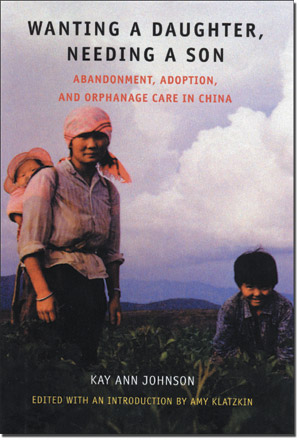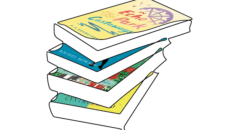Yeong & Yeong; 2004
Buy Wanting a Daughter, Needing a Son on Amazon.com >
The questions that linger in the mind of most any adopted child are “Why?” “Why couldn’t they keep me?” “Why did I have to leave the place where I was born?”
Anyone with even a casual interest in adoption from China will think they know the answers to these “whys” for Chinese children: Couples are by law allowed only one child, and they want a son who will care for them in their old age. But this policy is a complicated and often misunderstood regulation that results in a litany of unnerving consequences. This book, by China scholar and adoptive mom Kay Johnson, starts with a relatively simple explanation of the one-child policy and goes on to explore the complexities of Chinese social policies, cultural beliefs, and parental preferences to provide nuanced answers to the Chinese adoptee’s questions.
Certainly, abandonment and international adoption are influenced by male-child preference and the one-child policy-which receive thorough, comprehensible explanations. But there’s much more. Johnson digs deep to provide real, rather than myth-based, explanations of the social and political pressures that propel baby-girl abandonment and adoption in China. She shows how the loosening of the population-control policy in the 1990s had a surprisingly negative effect on child abandonment. More babies filled China’s welfare institutions, because the slightly easier constraints on family growth were more rigorously enforced.
Johnson offers new insights about adoption by Chinese families and the current status of orphanage care, making the book a must-read for adoption professionals, as well as adoptive families who long for accurate information about their Chinese children.
As an adoptive parent, I was particularly fascinated (and horrified) to learn about the plight of my counterparts in China. Many Chinese adoptive parents are penalized by the population-control authorities, as if they were the ones who had illegally given birth to their adopted children. Monetary fines can range up to the equivalent of a year’s income. Adopted children are often denied full legal status, as well as benefits, health care, and entitlements given to other children. School enrollment can be difficult and expensive. In spite of these hardships, adoption is not uncommon in China. In fact, studies have found that 4 to 5% of children in China were adopted, double the proportion of children adopted in the U.S.
For many families formed through Chinese adoption, the most intriguing revelation of this book may be that our children almost certainly have siblings-perhaps a sister and a brother-in China. Johnson says that when a girl child is abandoned, she is probably the second or third daughter born to a family trying for a son.
Each of the book’s chapters is an edited version of an academic paper published during the past 12 years. This format was chosen to provide an historical record for future adult adoptees-each chapter stands alone as a “time capsule.” Unfortunately, this makes for annoying repetition of statistics, definitions, and other background information. But it’s a minor irritant in light of the interesting, valuable, and critical insights offered in this important new work.
Reviewed by Susan Freivalds, Founder and Editorial Advisor of Adoptive Families.



